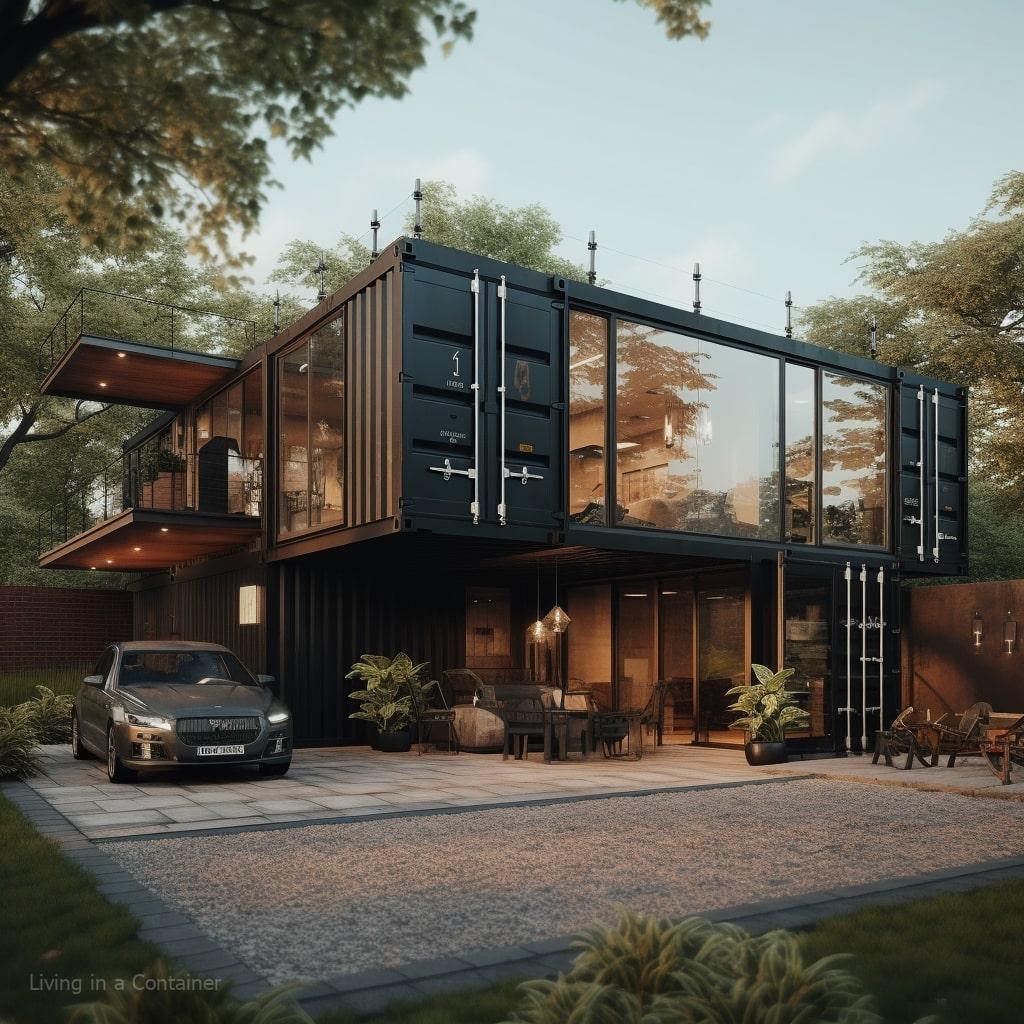In the modern era of sustainable living, one of the emerging trends is the transformation of shipping containers into innovative, eco-friendly homes.
This unconventional form of housing not only provides a cost-effective solution to traditional construction but also allows for creative architectural design, bringing a unique aesthetic to the housing market.
While the idea of residing within the steel walls of a shipping container may seem outlandish to some, the reality is that with careful planning, building regulations comprehension, efficient design, and careful material sourcing, these containers can be transformed into functional, comfortable, and stylish modern homes.

Understanding Building Regulations
Understanding Building Regulations and Codes
To build a shipping container home, you first need to understand the building regulations, codes, and laws that may impact your construction. These rules vary greatly from one locality to another, so it’s vital to familiarize yourself with the ones relevant to your area. Contact your local building department or zoning board for this information.
Understanding Zoning Laws
Zoning laws are regulations that govern how land in certain areas can be used. These laws can dictate where you can construct your shipping container home. They may stipulate restrictions on where residential, commercial, industrial, and other types of structures can be erected. Besides, zoning laws might also include specific requirements about the size, height, and placement of buildings.
Understanding Property Restrictions
Apart from zoning laws and building codes, you may also need to deal with property restrictions. Property restrictions, sometimes known as Covenants, Conditions & Restrictions (CC&Rs), can limit what you can build on a property, how large it can be, and what materials you can use.
Check for Specific Rules
In some areas, there may be specific rules about using shipping containers as living spaces. These could include regulations dictating utility connections, insulation, and modifications. Stick to these guidelines to avoid legal issues. Check with your local code enforcement office or a building inspector to learn about any potential rules regarding shipping container construction.
Thorough Understanding Is Crucial
Understanding all of these rules, laws, and codes is essential before you start your construction. A thorough understanding will prevent you from incurring extra costs, delays, or legal complications once construction has begun. Consult with professionals in the field, like an architect or a contractor well-versed in shipping container homes, who can offer valuable advice and help you navigate the regulations.
Get Professional Help With Regulations
While it is crucial to understand these regulations yourself, you may also want to enlist the help of professionals. A local builder or a real estate lawyer may be able to help you navigate the local codes and restrictions. They can also offer guidance on obtaining necessary permits required for your construction process.
Obtain the Required Permits
Before you start construction on your shipping container home, make sure you have obtained all necessary permits. These might include building permits, electrical permits, and plumbing permits, among others. The requirement for these permits will depend on the local laws and your project’s specifics. Visit your local town or city hall to apply for these permits.
Remember, it’s not just about the construction of your home, but it’s also about being compliant with regulations and laws.
The process may seem tedious, but compliance will ensure that your dream home is not just beautiful, but also legal and safe.

Designing the Home
Understanding the Space: Size and Shape of a Shipping Container
When designing a home out of a shipping container, it’s important to fully understand the size and shape of the container. The most common container sizes are 20ft and 40ft both in length, with a standard width of 8ft and height of 8.5ft. Some specialty containers can be larger, offering greater ceilings and more living space. The unique shape and limited square footage of a shipping container require careful space planning.
Creating Balance: Living Space Versus Storage
Balancing between living space and storage is crucial in a shipping container home due to the limited footprint. You need to think creatively about dual-purpose furniture and fixtures. For example, you could design a bed that folds up against the wall when not in use, or a table that can double as a storage cabinet. When planning the layout, order components based on usability and priority, such as placing kitchen near the entrance, bathroom adjacent to the bedroom, etc., to optimize flow and convenience.
Utilizing Natural Light: Designing with Light Sources in Mind
Considering light sources in your design plan is also a key component. Shipping containers are enclosed on all sides, apart from the doorways and windows you choose to install. This includes strategic placement of windows and skylights to maximize natural light, and employing reflective surfaces to enhance indoor illumination. You can also implement LED fixtures in areas requiring artificial lighting for energy efficiency.
Keeping it Warm: Methods for Efficient Insulation
Efficient insulation methods are vital when constructing a shipping container home due to its metal construction which can easily conduct heat. External options include spray foam insulation or insulated panels, while internal insulation choices could be fiberglass or insulated plasterboards. To decide which insulation method would suit your home the best, consider factors like your climate, budget, and local building regulations.
Design Software: Using Technology to Aid Design
There are a number of design software tools to help you with planning and visualizing layout efficiently. Some popular choices include SketchUp, AutoCAD, or Sweet Home 3D; these platforms help to create accurate floor plans and 3D models of your home. Learn to use this software to visualize your concept, adjust your plan, and ultimately design a comfortable, functional shipping container home.
Keep in mind that even though container homes are smaller, they shouldn’t skimp on the essentials of a full-sized home – a comfortable living room, a functional kitchen, a full bathroom, and a cozy bedroom. It’s all about clever design and making every square foot count.

Securing and Preparing the Containers
Purchasing Shipping Containers
Purchasing your shipping container is the first step in the process. You can purchase containers directly from shipping companies, leasing companies, or container retailers. When purchasing a shipping container, it is fundamental to consider its condition. You may want to focus on the structural integrity of the container. Look for any signs of severe rust, especially at the joints and corners, as this can indicate structural weakness. Ensure the doors are in working condition and that the seals are intact to prevent water leaks.
Transporting The Containers
Once you have purchased your container, you need to arrange transportation to your chosen site. Some sellers might offer delivery, but this is not always the case. If not, you will need to hire a trucking company that specializes in transporting containers. Remember, you will also need specialty equipment like a crane or large forklift to move and position the container on your site.
Preparing The Containers
After you get the container on site, the next step is to prepare it for modification. Begin by cleaning the interior thoroughly. Depending on what the container was previously used for, it might contain some harmful substances. Therefore, do a thorough clean with industrial cleaning chemicals. Allow the container to dry with sufficient air circulation afterward.
Modifying The Containers
The modification process involves adding doors and windows to the shipping container to transform it into a livable space. Plan out the layout of your home and mark where you would like to add these features.
To add windows and doors, you will need to cut out sections of the steel walls. This task requires a plasma cutter or similar tool. Be sure to protect yourself with safety equipment like goggles and gloves during this procedure.
After cutting, you can weld in steel window frames and door frames. This will strengthen the structural integrity of the container, as cutting can weaken the steel.
Last but not least, fit your windows and doors, ensuring a tight seal to prevent drafts and leaks.
Ensuring Safe Living Quarters
Finally, remember to modify shipping containers following necessary safety measures. Although these containers might seem robust and durable, lack of proper modification can lead to accidents and injuries. After all, these containers were designed for freight, not human habitation.
Always use professional services for plumbing and electrical works. Moreover, ensure proper insulation and ventilation are installed to provide a comfortable and safe environment.
Furthermore, always consult local building codes and engage the services of a professional inspector to ensure all work is up to standard.
Securing and preparing shipping containers can be a challenging process, but with careful planning and execution, you can successfully convert these industrial giants into a unique and functional living space.

Building and Finishing the Home
Choosing a Suitable Foundation
The first step in building a shipping container home is to lay a suitable foundation. This is crucial for structural stability and longevity. Options include concrete slab, pile foundation, and strip foundation. For shipping container homes, a concrete slab foundation or pile foundation is typically used. They offer the required strength. The choice largely depends on your local climate and the ground conditions.
Delivering and Placing the containers
Once the foundation is ready, you need to arrange delivery of the shipping containers. Due to their size and weight, a crane or forklift is used to position containers on the foundation. Your choice of home layout will determine how the containers are placed, whether they’re stacked on one another, aligned side by side, or staggered for an innovative design.
Cutting and Welding Container Sections
Post placement, modifications to the shipping container are needed to make it more livable. This involves cutting and welding sections to create doors, windows, and internal walls if you’re using more than one container. Safety measures should be undertaken during this stage, including wearing suitable protective gear and ensuring proper ventilation to prevent inhaling harmful fumes.
Installing the Utility Lines
Following this, the utility lines are installed. Plumbing, electrical, and HVAC systems are integrated into the container. Depending on your preference, these could be installed within the floor or walls, or externally. It’s crucial to have a proper plan in place before starting this step. Always consult with a professional to ensure all installations meet required safety standards.
Insulating Your Container Home
Insulation is paramount to prevent heat loss in winter and heat gain in summer in your container home. The two main types of insulation are blanket insulation, which is cheaper and easier to install, and Spray foam insulation, which despite being more costly, offers a higher insulation value. Your choice of insulation should be largely determined by your local climate.
Fitting Interior Walls and Flooring
Once insulated, install the interior walls and flooring. Walls can be constructed from drywall, plywood, or paneling while flooring options include laminate, hardwood, or tiles. Before committing to materials, ensure they’re durable and suitable for your lifestyle.
Fitting Exterior Finishes
For the exterior, you can leave the container’s corrugated steel surface as is or cover it with cladding, paint or other finishes to improve its aesthetic appeal. You can also consider adding a roof to protect against weather damage.
Throughout this entire process, always consider local building codes and regulations, and seek out permissions and inspections where required to ensure your shipping container home is safe, legal, and durable. This includes zoning laws, which dictate where you can build particular types of homes.

Embracing a new kind of sustainable living, shipping container homes offer an alternative to traditional housing.
They are not just cost-effective but also an environmentally friendly choice that reduces the waste associated with conventional construction methods. The journey from understanding building regulations, to the challenging yet creative part of designing, followed by preparing containers and inevitably turning them into a livable space, is truly rewarding.
Knowledge gained in this process introduces you to an entire realm of opportunities for creating flexible, sustainable, and astonishing living spaces by repurposing shipping containers.
It shines a light on the boundless capabilities of progress when determination meets functionality, underscoring how sustainable solutions can transform the way we live for the better.

Really helpful. Thanks!